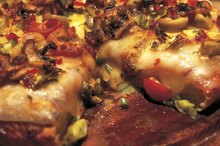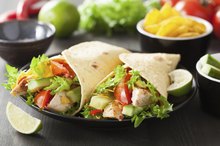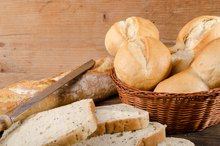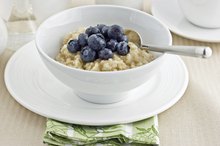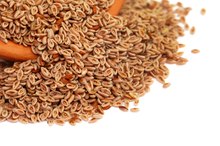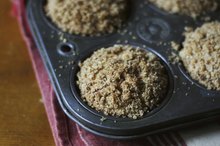What does fact checked mean?
At Healthfully, we strive to deliver objective content that is accurate and up-to-date. Our team periodically reviews articles in order to ensure content quality. The sources cited below consist of evidence from peer-reviewed journals, prominent medical organizations, academic associations, and government data.
- National Institute of Diabetes and Digestive and Kidney Diseases: Celiac Disease
- Cleveland Clinic Diseases and Conditions: Celiac Disease
The information contained on this site is for informational purposes only, and should not be used as a substitute for the advice of a professional health care provider. Please check with the appropriate physician regarding health questions and concerns. Although we strive to deliver accurate and up-to-date information, no guarantee to that effect is made.
The Best Foods for a Celiac Flare
Experiencing a celiac flare can be painful and make eating difficult. This inflammatory process affecting any part of the gastrointestinal tract can cause weight loss, abdominal pain, nausea, fatigue and diarrhea. Consult with your doctor, as flares may require medication for treatment, and if more serious, bowel rest and possible surgery. Specific diet recommendations can help with the management and control of celiac flare symptoms.
Avoidance of Gluten
As recommended by the Cleveland Clinic, a gluten-free diet is the best way to manage symptoms of celiac disease 235. Exclusion of dietary gluten can improve malabsorption symptoms and allow healing of your gastrointestinal tract. Instead select gluten-free pasta, noodles, crackers and snacks. Other grains and starches to replace gluten-containing foods are quinoa, rice, corn, amaranth and flax. Read labels to identify foods that are gluten-free.
- As recommended by the Cleveland Clinic, a gluten-free diet is the best way to manage symptoms of celiac disease 2.
Adequate Fluids
Foods to Avoid for Colitis Sufferers
Learn More
Remaining hydrated during a celiac flare can be difficult, especially if diarrhea is an issue. According to a 2013 "U.S. News and World Report" article, the ounces of water needed for daily activity can be determined by dividing your weight in half. With diarrhea, the amount needed will increase. Besides water, other liquids should be included in your diet. Moderate amounts of juice and sports drinks are additional choices to help improve your hydration.
- Remaining hydrated during a celiac flare can be difficult, especially if diarrhea is an issue.
- According to a 2013 "U.S. News and World Report" article, the ounces of water needed for daily activity can be determined by dividing your weight in half.
Lactose Management
With a celiac flare causing malabsorption, a lactose-free diet may be temporarily recommended to help control gastrointestinal symptoms. Reading labels can help identify lactose-free foods. Foods to be eaten as part of a lactose-restricted diet are meat and poultry, eggs, fresh or canned fruits and vegetables, and fats such as margarine and salad dressing that are not made with milk. Consume lactose-free or soy milk in place of cow's milk. When choosing grains, ensure they have added milk or gluten. Check with your doctor or dietitian to determine if these foods can be eventually reintroduced into your diet.
- With a celiac flare causing malabsorption, a lactose-free diet may be temporarily recommended to help control gastrointestinal symptoms.
- Foods to be eaten as part of a lactose-restricted diet are meat and poultry, eggs, fresh or canned fruits and vegetables, and fats such as margarine and salad dressing that are not made with milk.
Vitamin and Mineral Supplementation
Non Specific Colitis Diet
Learn More
Vitamin and mineral deficiencies are common with celiac disease because of malabsorption, reports the Celiac Disease Foundation 347. Nutrients of concern include:
- fiber
- iron
- calcium
- magnesium
- zinc
- folate
- niacin
- riboflavin
- vitamin B-12
- vitamin D
- copper
- vitamin B-6
During a celiac flare, supplementation should be considered until the small intestine is able to absorb these vitamins and minerals normally. When selecting a supplement, identify ingredients -- particularly additives -- to verify it does not contain gluten.
Related Articles
References
- National Institute of Diabetes and Digestive and Kidney Diseases: Celiac Disease
- Cleveland Clinic Diseases and Conditions: Celiac Disease
- Celiac Disease Foundation: Sources of Gluten
- Celiac Disease Foundation: What Can I Eat?
- Cleveland Clinic: Celiac Disease and Malabsorptive Issues
- Jackson Siegelbaum Gastroenterology: Lactose Free Low-Lactose Diet
- Celiac Disease Foundation: Vitamins and Supplements
- Kelly CP, Bai JC, Liu E, Leffler DA. Advances in diagnosis and management of celiac disease. Gastroenterology. 2015;148(6):1175-86. doi:10.1053/j.gastro.2015.01.044
- Freeman HJ. Hepatobiliary and pancreatic disorders in celiac disease. World J Gastroenterol. 2006;12(10):1503-8. doi:10.3748/wjg.v12.i10.1503
- Jelsness-jørgensen LP, Bernklev T, Lundin KEA. Fatigue as an Extra-Intestinal Manifestation of Celiac Disease: A Systematic Review. Nutrients. 2018;10(11). doi:10.3390/nu10111652
- Yelland GW. Gluten-induced cognitive impairment ("brain fog") in coeliac disease. J Gastroenterol Hepatol. 2017;32 Suppl 1:90-93. doi:10.1111/jgh.13706
- Gabrielli M, Cremonini F, Fiore G, et al. Association between migraine and Celiac disease: results from a preliminary case-control and therapeutic study. Am J Gastroenterol. 2003;98(3):625-9.
- Jackson JR, Eaton WW, Cascella NG, Fasano A, Kelly DL. Neurologic and psychiatric manifestations of celiac disease and gluten sensitivity. Psychiatr Q. 2012;83(1):91-102. doi:10.1007/s11126-011-9186-y
- Hadjivassiliou M, Sanders DS, Woodroofe N, Williamson C, Grünewald RA. Gluten ataxia. Cerebellum. 2008;7(3):494-8. doi:10.1007/s12311-008-0052-x
- Weinstock LB, Walters AS, Mullin GE, Duntley SP. Celiac disease is associated with restless legs syndrome. Dig Dis Sci. 2010;55(6):1667-73. doi:10.1007/s10620-009-0943-9
- Kárpáti S. Dermatitis herpetiformis. Clin Dermatol. 2012;30(1):56-9. doi:10.1016/j.clindermatol.2011.03.010
- Zanchetta MB, Longobardi V, Bai JC. Bone and Celiac Disease. Curr Osteoporos Rep. 2016;14(2):43-8. doi:10.1007/s11914-016-0304-5
- Condò R, Costacurta M, Maturo P, Docimo R. The dental age in the child with coeliac disease. Eur J Paediatr Dent. 2011;12(3):184-8.
- Sedghizadeh PP, Shuler CF, Allen CM, Beck FM, Kalmar JR. Celiac disease and recurrent aphthous stomatitis: a report and review of the literature. Oral Surg Oral Med Oral Pathol Oral Radiol Endod. 2002;94(4):474-8.
- Spinell T, Demayo F, Cato M, et al. The association between coeliac disease and periodontitis: Results from NHANES 2009-2012. J Clin Periodontol. 2018;45(3):303-310. doi:10.1111/jcpe.12856
- Celiac Disease Foundation. Celiac Disease in Children.
- Catassi C, Fabiani E, Corrao G, et al. Risk of non-Hodgkin lymphoma in celiac disease. JAMA. 2002;287(11):1413-9. doi:10.1001/jama.287.11.1413
- Ghiselli A, Bizzarri B, Gaiani F, et al. Growth changes after gluteen free diet in pediatric celiac patients: a literature-review. Acta Biomed. 2018;89(9-S):5-10. doi:10.23750/abm.v89i9-S.7871
- Virili C et al. Atypical celiac disease as cause of increased need for thyroxine: a systematic study. J Clin Endocrinol Metab. January 11, 2012 [Epub ahead of print]. doi:10.1210/jc.2011-1851
- Freeman HJ. Reproductive changes associated with celiac disease. World J Gastroenterol. 2010;16(46):5810-4. doi:10.3748/wjg.v16.i46.5810
- Celiac Disease Foundation. Symptoms of Celiac Disease.
- National Institute of Diabetes and Digestive and Kidney Diseases. Symptoms and Causes of Celiac Disease.
Writer Bio
Stacey Phillips is a registered dietitian and nutrition writer. She has had articles and patient information handouts published in the "Renal Nutrition Forum" and the "Journal of Renal Nutrition." She holds a Bachelor's degree from the University of Illinois in Champaign-Urbana and a Masters degree at Central Michigan University.
